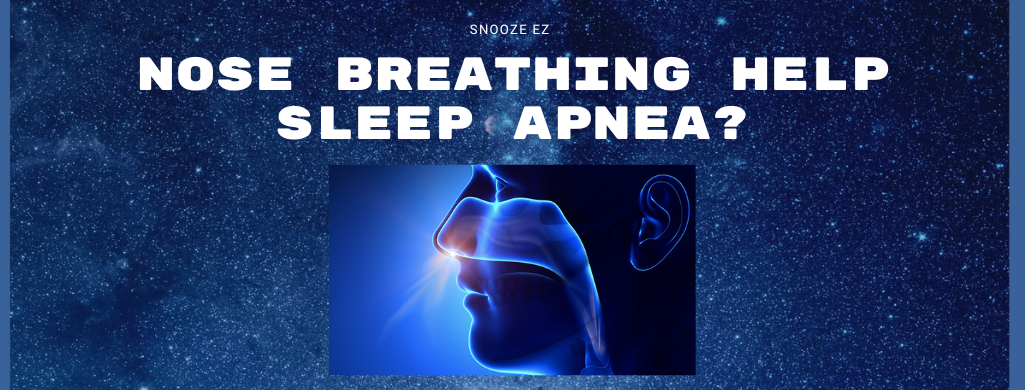Yes, nose breathing can help obstructive sleep apnea.
Nose breathing is an age-old technique that has been used for centuries to promote relaxation and better sleep. The concept is simple, inhale through your nose and exhale through your nose. Nose breathing has several benefits, including filtering the air and humidifying it, which can help reduce the symptoms of sleep apnea.
If you suffer from sleep apnea, you are not alone, and there are many treatment options available. However, before trying any medication or therapy, it’s essential to understand how nose breathing can help alleviate your sleep apnea symptoms. In this article, we will explore the science behind nose breathing and explain how it can help you get a better night’s rest.
How does nose breathing help sleep apnea?
Nose breathing is a simple and effective way to reduce the risk of obstructive sleep apnea (OSA). Research shows that having your mouth open while sleeping allows soft tissues in the throat and tongue to collapse, which can cause snoring or OSA.
By using nasal breathing instead of mouth-breathing during sleep, airways remain open for better airflow. This reduces the chances of apneas and ensures that oxygen levels remain at normal levels throughout the night.
Additionally, it helps to clear mucus from your nose and throat, which can further improve airflow. This also ensures that the correct amount of filtered air is entering the lungs and body, which not only helps people to enjoy peaceful nights but also helps prevent conditions such as diabetes and heart disease.
Moreover, nasal breathing is highly recommended for patients already wearing positive airway pressure devices due to their OSA symptoms. Unless there is complete or near-complete nasal obstruction, they should not breathe through their mouths. This can increase airway collapse because oral breathing promotes poorer airflow at night than nasal breathing does.
So if someone has been diagnosed with OSA, then it’s important for them to accommodate themselves to nasal breathing even when on CPAP therapy. Nasal breathing through CPAP still helps to have better quality of sleep compared to mouth-breathing as long as there isn’t any obstructions in the nasal passages.
Can nose breathing cure sleep apnea?
No, nose breathing cannot cure sleep apnea the same as nasal strips can not either. Although it may help reduce the symptoms of sleep apnea, it is not a cure and should only be used in conjunction with other treatments. Many people use nasal breathing as part of their treatment plan to help manage their condition.
Nose breathing can provide some relief from symptoms such as snoring, dry mouth, and difficulty sleeping due to airway obstruction. It can also improve one’s overall quality of sleep by increasing air flow through the nose and allowing for better oxygen exchange in the lungs. However, it is important to note that nose breathing alone will not stop or reverse the effects of OSA.
Though, nasal breathing can be used as a preventative measure for those who are not diagnosed with OSA. Developing healthy nasal breathing habits can help improve overall quality of sleep and reduce the risk of developing OSA in the future. Studies have shown that regular nose-breathing reduces snoring, improves concentration, and increases energy levels.
How to nasal breathe while sleeping?
Nasal breathing while sleeping is a simple technique to relax and promote better sleep. To practice nasal breathing, start by lying down in a comfortable position. Then, place your hand on your belly and breathe in deeply through your nose, allowing the air to fill your lungs and raise your belly. Exhale slowly through both nostrils and allow your body to relax as you feel your stomach deflate back to normal. Repeat this process for several breaths until you feel relaxed and ready for sleep.
It’s important to remember that the goal of nasal breathing during sleep is not to take deep breaths or reach any specific level of oxygenation. Rather, it is simply about slowing down and relaxing so that you can get into a restful state. If you need help controlling your breathing, you can try using a breathing app or audio cue to help you stay on track.
Additionally, nose-breathing is easy to incorporate into a daily routine. Simply using it throughout your day can help make it a habit that sticks during sleep as well. To increase effectiveness, practice nasal breathing while doing activities such as walking or working out. This will help you get used to breathing through your nose and make it easier to do so during sleep.
If you still can’t manage to keep your mouth closed at night while sleeping, you may want to look into trying a chin strap or mouth tape. Due to possible nasal congestion or obstruction that could be blocking your nasal passages, mouth tape is not recommended unless you have discussed this option with your doctor.
Conclusion
Overall, nasal breathing can help to reduce symptoms of sleep apnea, improve overall quality of sleep, and reduce the risk of developing OSA in the future.
It is important to note that it should not be used as a cure, but rather as part of a larger treatment plan. Additionally, it is easy to incorporate into your daily routine and can help you achieve a more restful sleep.


